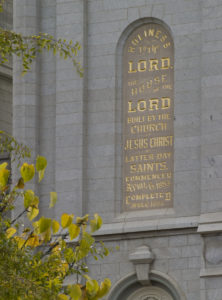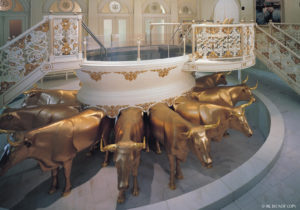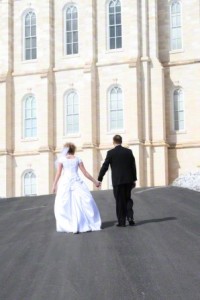 The most sacred structure to Latter-day Saints is the Temple. Of course, what makes the Temple sacred has nothing to do with the building; it is because of the holy ordinances that are performed inside. The Church teaches that only through those ordinances are the greatest blessings available through the Atonement to be had1. The Church also teaches that Temple ordinances have been around since the time of Adam2. By contrast, most anti-Mormons believe that they are a modern invention, a mixture of Joseph Smiths imagination and plagiarized Freemason ritual. This is simply not true. Although not a comprehensive analysis, I hope to give throughout this post a glimpse of the plentiful evidences that these ordinances were practiced anciently, and that divine revelation to Joseph Smith is a much better explanation for their genesis than pretending he made it up.
The most sacred structure to Latter-day Saints is the Temple. Of course, what makes the Temple sacred has nothing to do with the building; it is because of the holy ordinances that are performed inside. The Church teaches that only through those ordinances are the greatest blessings available through the Atonement to be had1. The Church also teaches that Temple ordinances have been around since the time of Adam2. By contrast, most anti-Mormons believe that they are a modern invention, a mixture of Joseph Smiths imagination and plagiarized Freemason ritual. This is simply not true. Although not a comprehensive analysis, I hope to give throughout this post a glimpse of the plentiful evidences that these ordinances were practiced anciently, and that divine revelation to Joseph Smith is a much better explanation for their genesis than pretending he made it up.
Before getting into the heart of the subject, I want clarify a couple of things. First, I am not suggesting that early Temple ritual was a carbon copy of what is practiced today. We just don’t know exactly what the ordinances were like in ancient times. How they are performed has been changed from time to time by the presiding authorities to better meet the needs of the Church membership (one of the beauties of continuing revelation), and so there is no need to assume that the ordinances have remained unchanged throughout history. Also, it is entirely possible that there have been periods of time where the full spectrum of Temple ordinances has not been available on the earth (for example after the Children of Israel lost the Melchizedek Priesthood). But since those ordinances are critical to our salvation, the essential core aspects would have remained the same throughout time, and would have been known to the faithful. As I hope to demonstrate, there are many evidences of this found within ancient texts and traditions.
Second, I’m purposefully not discussing in detail any connections to Freemasonry. This has been explored extensively, and FairMormon has plenty on the subject. The primary purpose of this post is to discuss documents and traditions relating to the Temple that pre-date Freemasonry. From my point of view, any connection between Temple ritual and Freemasonry need not be distressing. I believe that it is entirely possible (if not probable) that Joseph Smith was inspired to become a Mason so that he could better learn how to use dramatic ritual and symbols to teach complex ideas; and while some similarities undoubtedly exist, you cannot explain the ordinances of the Temple by looking at Freemasonry alone.
Baptisms for the Dead
 The first ordinance that I want to discuss is Baptisms for the Dead. This is only hinted at in the Bible (see 1 Corinthians 15:29), but it was indeed practiced by some early orthodox Christian Churches and even continued through the centuries with the Coptic Christians. Although there is no evidence that this was practiced among ancient Jews, the argument has been made that sacrifice essentially served the same purpose as baptism (in that it cleansed the participant from sin), and there is evidence that sacrifices were performed vicariously on behalf of the deceased3.
The first ordinance that I want to discuss is Baptisms for the Dead. This is only hinted at in the Bible (see 1 Corinthians 15:29), but it was indeed practiced by some early orthodox Christian Churches and even continued through the centuries with the Coptic Christians. Although there is no evidence that this was practiced among ancient Jews, the argument has been made that sacrifice essentially served the same purpose as baptism (in that it cleansed the participant from sin), and there is evidence that sacrifices were performed vicariously on behalf of the deceased3.
The practice of vicarious baptism was eventually deemed heretical, the interpretation of 1 Corinthians 15:29 was restricted, and other interpretations of the verse were promulgated. The original meaning was lost, and the ordinance was ultimately discontinued4. It is very unlikely that Joseph Smith was aware that Baptism for the Dead was performed by these early orthodox and Coptic churches. Nevertheless, he saw past the interpretations of his day, understood the original meaning of that scripture, and restored an authentic and ancient practice.
Initiatory Ordinances
Out of all the ordinances of the temple, the initiatory ordinances, or the ordinances of washing, anointing, and clothing in special garments, is the most well documented in the Scriptures (see Exodus 40:12-15). This was also found among early Jews as a practice with Heavenly parallels as read in the apocryphal book of 2 Enoch 22: 8-10: “And the Lord said to Michael, ‘Go, and extract Enoch from [his] earthly clothing. And anoint him with my delightful oil, and put him into the clothes of my glory.’ And so Michael did, just as the Lord had said to him. He anointed me and he clothed me. And the appearance of that oil is greater than the greatest light, and its ointment is like sweet dew, and its fragrance like myrrh; and it is like rays of the glittering sun. And I looked at myself, and I have become like one of his glorious ones.” Other Jewish texts also show angels washing, anointing, and clothing people in preparation to come into the presence of God. This practice continued with the early Christians in conjunction with the baptismal ordinance. Also, the initiation rite of kings and orthodox priests/bishops is reminiscent of, and probably derived from, this ordinance5. Once again we see Joseph Smith restoring an early Christian and ancient Jewish practice that had been all but lost to the religions of his day.
Endowment
The endowment, as defined by Brigham Young, “is to receive all those ordinances in the House of the Lord, which are necessary for you, after you have departed this life, to enable you to walk back to the presence of the Father, passing the angels who stand as sentinels, being able to give them the key words, the signs and tokens, pertaining to the holy Priesthood, and gain your eternal exaltation in spite of earth and hell.”6. In other words, the Endowment deals with the motif of us ascending into the presence of God, but only being admitted after proving to those who guard the way that we have been faithful and have the knowledge necessary to enter His presence.
The general theme of ascension is a rich tradition among early Christians and Jews7. It is found in the New Testament in (2 Corinthians 12), the Old Testament (Genesis 28:10-228, Isaiah, and Micah), and even in the architecture of the early Israelite Temples9. But getting even more specific, early apocryphal literature is prevalent with the theme of the faithful having to pass by angels or other guardians to enter into Heaven- and in many cases they are required to give specific signs and names to the sentinels before they can be admitted. Perhaps the most interesting account in apocryphal literature is found in the Coptic 1 Jeu, chapters 33-40. This story describes Jesus instructing the apostles regarding the names, hand-signs (called ciphers) and seals that they must use before the guardians of the heavens will remove the veils and allow them to enter. Even more interesting is that in 1 Jeu 33 blanks and number-codes are used to conceal material that should not be revealed because it was presumably too sacred for all to see. This is only one example, there are many others in early Christian and Jewish literature prevalent with the theme of needing to pass by angels using signs and secret words before being able to enter heaven10.
This theme is not limited to ancient Christians and Jews, but is also found among other faith traditions. One such Islamic legend is remarkably similar: The story of Muhammad ascending into heaven tells of him coming up through seven heavens, each one separated by a curtain and behind each curtain is a prophet from a former time who stands as a guardian. In order for Muhammad to pass through the curtain he must answer certain questions to determine whether he is qualified to enter in. After he answers the question correctly he is admitted into that heaven. In the end he is able to enter into the presence of God11.
Again we see Joseph Smith reaching beyond his time to ancient themes and practices that he could have had no real knowledge of or exposure to—and the above sources are only a small part of the literature available supporting an ancient source for the modern Temple endowment. In my mind, there is no way that Joseph Smith could have made up something so complex and so authentic using only contemporary sources available to him. Perhaps that argument could have been made if he was a scholar with extensive knowledge of ancient Jewish and Christian writings, but he was instead an uneducated farmer. As unrealistic as it may be for some, to me divine revelation is a more logical and plausible explanation of the source of the endowment.
Sealing Ordinances
 Finally, we come to the sealing ordinances or the binding of families together for eternity. This concept is hinted at in the Bible when Jesus is asked the hypothetical question about who a woman would be with after the resurrection if she were married to successive husbands on earth (see Matthew 22:8). This shows that the Jews apparently had at least some concept of being married in the eternities. This concept is also shown to be well established among medieval Jews.12
Finally, we come to the sealing ordinances or the binding of families together for eternity. This concept is hinted at in the Bible when Jesus is asked the hypothetical question about who a woman would be with after the resurrection if she were married to successive husbands on earth (see Matthew 22:8). This shows that the Jews apparently had at least some concept of being married in the eternities. This concept is also shown to be well established among medieval Jews.12
Ancient apocryphal writings also deal with this theme. In the book of Joseph and Aseneth (a pseudepigraphic expansion of the Book of Genesis) the patriarch is told that his new bride “shall be your wife from now on and forever (and) ever.” The book of Tobit tells the story of a woman named Sara, who was married to seven men, but each of them died on the wedding night. In the story she is given to another husband (her eighth) by the archangel Raphael. Significantly, this is probably the source of the question posed to Jesus in Matthew. When Jesus rebuked his questioners saying “Ye do err, not knowing the scriptures, nor the power of God” (Matthew 22:29), it was because they had failed to remember that she had married another husband, and an archangel had been sent to orchestrate the ceremony.13
In Joseph Smiths day, the concept of being married for all eternity had been replaced by a temporal institution that lasted “until death do us part.” But again, the idea of a forever marriage is ancient. The fact that Joseph restored this is yet another evidence of the ancient origin of Temple ordinances.
As I hopefully have demonstrated, each one of the ordinances performed in the Temple is rooted in antiquity. We of course cannot “prove” the divinity of Temple ritual using scholarly sources; it is primarily a matter of faith. But looking at all the evidences together a very strong case is built for the divine calling of the Prophet Joseph Smith, and the sacred and authentic nature of the Temple.
As we continue to worship in the Temple throughout our lives, let us not forget where these ordinances came from. They are gifts from a loving God given to help guide us back into His presence. He is the source, and in a very real sense the Temple is the House of the Lord. Let us always remember that and never take for granted the privilege that is ours to enter into that holy place where heaven meets the earth.
Notes
- Temples (n.d.). LDS Gospel Topics. Retrieved from https://www.lds.org/topics/temples?lang=eng
- Benson, Ezra T (1985). “What I Hope You Will Teach Your Children About the Temple.” Retrieved from https://www.lds.org/ensign/1985/08/what-i-hope-you-will-teach-your-children-about-the-temple?lang=eng
- Tvedtnes, John A (1981). “Baptism for the Dead: The Coptic Rationale.” Retrieved from http://www.fairmormon.org/perspectives/publications/baptism-for-the-dead-the-coptic-rationale
- Stendahl, Krister (1992). “Baptism for the Dead: Ancient Sources.” Retrieved from http://eom.byu.edu/index.php/Baptism_for_the_Dead
- Tvedtnes, John A (1999). “Early Christian and Jewish Rituals Related to Temple Practices.” Retrieved from http://www.fairmormon.org/perspectives/fair-conferences/1999-fair-conference/1999-early-christian-and-jewish-rituals-related-to-temple-practices
- Discourses of Brigham Young, comp. John A. Widtsoe [Salt Lake City: Deseret Book Co., 1971], page 416
- Peterson, Daniel C (2009). “The Temple as a Place of Ascent to God.” Retrieved from http://www.fairmormon.org/perspectives/fair-conferences/2009-fair-conference/2009-the-temple-as-a-place-of-ascent-to-god
- Romney, Marion G (1971). “Temples—The Gates to Heaven.” Retrieved from https://www.lds.org/ensign/1971/03/temples-the-gates-to-heaven.p1?lang=eng. Interestingly President Marion G. Romney stated that this experience of Jacobs was analogous to the experience that we receive in the Temple
- Peterson, Daniel C (2009). “The Temple as a Place of Ascent to God.” Retrieved from http://www.fairmormon.org/perspectives/fair-conferences/2009-fair-conference/2009-the-temple-as-a-place-of-ascent-to-god . They were laid out in three parts: the lower court (representing the abode of the dead), the holy place (representing the earth), and the holy of holies (representing heaven). The idea being the deeper you went into the temple the closer you get to God. This same idea is obviously present in our temples today.
- Tvedtnes, John A (1999). “Early Christian and Jewish Rituals Related to Temple Practices.” Retrieved from http://www.fairmormon.org/perspectives/fair-conferences/1999-fair-conference/1999-early-christian-and-jewish-rituals-related-to-temple-practices
- Peterson, Daniel C (2009). “The Temple as a Place of Ascent to God.” Retrieved from http://www.fairmormon.org/perspectives/fair-conferences/2009-fair-conference/2009-the-temple-as-a-place-of-ascent-to-god
- Mormon ordinances/Marriage/Jews and early Christians on marriage after death (n.d.). FairMormon Answers. Retrieved from http://en.fairmormon.org/Mormon_ordinances/Marriage/ Jews_and_early_Christians_on_marriage_after_death
- Ibid.

In Africa particularly Wakirike an ethnic group in Nigeria Ijaw, performs till date a marriage called Iya which is eternal in nature.
Just curious. In the second paragraph you referenced the children of Israel losing the “Melchezidek (sp)” priesthood, instead of Melchizedek. Was that intentional? Your spelling is in line with the most common pronunciation of the word in the church, but in some cases, in the endowment audio, the pronunciation is more like the latter. Seems like there would be more emphasis on the proper pronunciation of this important name among church leaders, although it is certainly not a big issue.
That was unintentional on my part, thanks for pointing that out
Oliver, Thank you for your insightful article.
Over the last several years I have become aware of many parallels between the modern temple endowment, and the potlatch ceremonies practiced by pre-contact and contemporary native Americans and Canadian first nations people of the Pacific Northwest Coast. Some of the similarities are in the telling of their traditional creation stories, but the strongest likenesses occur in their ceremonial procedure, rites of initiation, building architecture, physical accouterments and sacred clothing such as headdresses, aprons and robes. Do you know of any LDS scholars who are researching this field, or who would be interested in investigating the data? Thank you for your consideration.
Eric Pond, Vancouver, Washington USA
Eric,
Thank you for your comment. I unfortunately do not know anyone researching that topic at this time.